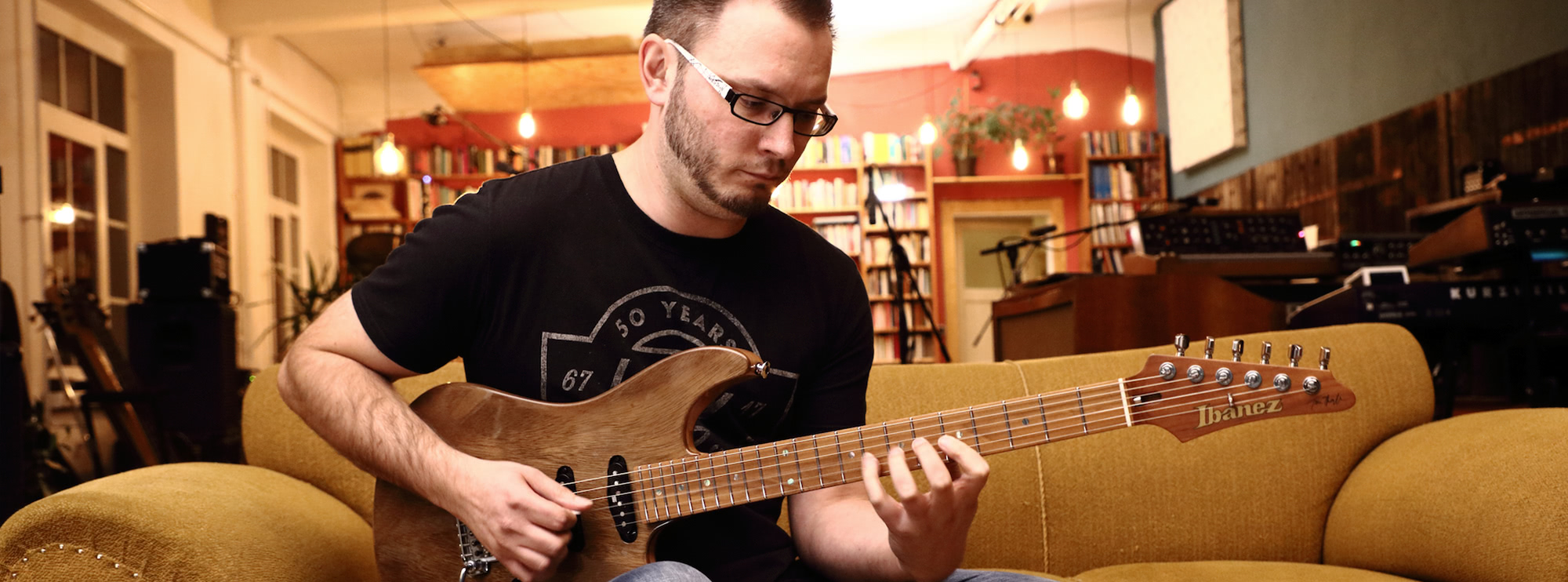Van Halen's "1984" - An in depth analysis for guitarists
"1984" is the sixth studio album by American rock band Van Halen, released on January 9, 1984. This album showcases the band's unique blend of hard rock, pop, and innovative guitar techniques, resulting in a record that would forever change the landscape of rock music. This analysis aims to provide guitarists with an in-depth understanding of each song, with a focus on guitar scales, solos, and the techniques employed by the legendary Eddie Van Halen.
In this guitar lesson course, LickLibrary veteran, Jamie Humphries walks you through the many highlights of each song from this hard rock gem, one phrase at a time, including all of Eddie Van Halen’s legendary guitar parts from the tracks; “Hot for Teacher,” “Panama,” and the iconic, “Jump.”
Track-by-Track Analysis
1. "1984"
The album begins with the instrumental synthesiser intro "1984," which sets the stage for the explosive guitar work to come. Though not guitar-driven, it foreshadows the experimentation and innovation that characterizes the rest of the album.
2. "Jump"
"Jump" is driven by its catchy keyboard riff and features a guitar solo in the key of C major. The chord progression mainly revolves around C, G, and F chords, with occasional D minor chords. Eddie Van Halen uses a combination of alternate picking and legato techniques to create a fluid and melodic solo. He also employs two-handed tapping and pull-offs to add a sense of excitement to the solo.
3. "Panama"
"Panama" features a driving rhythm and a memorable guitar riff in the key of E minor. The song's intro uses palm muting and power chords to create a tight, punchy sound. During the solo, Eddie Van Halen utilizes double-stop bends, pinched harmonics, and whammy bar tricks to create a high-energy performance. The solo ends with a rapid-fire tremolo picking section that showcases his exceptional technique.
4. "Top Jimmy"
"Top Jimmy" is a mid-tempo rocker in the key of A major. The song features a funky, syncopated rhythm guitar part that incorporates double stops, slides, and string bending for added flair. The guitar solo employs pre-bends, unison bends, and hammer-ons to create a melodic and expressive performance.
5. "Drop Dead Legs"
"Drop Dead Legs" is a hard-hitting track in the key of A minor. The song's main riff uses galloping rhythms and palm muting to create a heavy, driving feel. During the chorus, Eddie employs open-string riffs and octave melodies to add depth and texture to the song. The solo section showcases a combination of legato, two-handed tapping, and arpeggios to create a soaring, melodic passage that contrasts with the heaviness of the rest of the track.
6. "Hot for Teacher"
"Hot for Teacher" is an iconic Van Halen track known for its blazing tempo and intricate guitar work. The song is in the key of A major and features a complex, syncopated rhythm guitar part that includes hammer-ons, slides, and syncopated rhythms. The solo is a masterclass in alternate picking, with Eddie incorporating tapped harmonics, pinched harmonics, and dive bombs for added intensity.
7. "I'll Wait"
"I'll Wait" is a power ballad in the key of D major that showcases the band's more melodic side. The song's chord progression features a mixture of D, G, Bm, and A chords, with the guitar part utilizing barre chords and arpeggiated chord progressions to create a lush, atmospheric sound. The solo highlights Eddie's melodic sensibilities, as he employs vibrato, string bending, and slides to create a soulful and emotive performance.
8. "Girl Gone Bad"
"Girl Gone Bad" is an up-tempo rocker in the key of E minor, featuring a driving rhythm guitar part that incorporates palm muting, power chords, and chromaticism. The guitar solo is a showcase of Eddie's technical prowess, as he combines alternate picking, legato, and two-handed tapping to create a high-energy, virtuosic performance. Additionally, he employs sweep picking and rakes to add a sense of fluidity to the solo.
9. "House of Pain"
"House of Pain" closes the album with a heavy, blues-infused track in the key of E minor. The main riff utilises bluesy bends, double stops, and palm muting to create a raw, aggressive sound. The solo features a mix of pinched harmonics, trills, and unison bends, showcasing Eddie's ability to infuse his playing with a sense of bluesy swagger.
Eddie Van Halen's Contribution to "1984"
Eddie Van Halen's innovative and groundbreaking guitar work is a cornerstone of the "1984" album. His use of advanced techniques, such as two-handed tapping, sweep picking, and dive bombs, set a new standard for rock guitarists and influenced countless players in the years that followed. Eddie's ability to blend technical prowess with melodic sensibilities and a keen sense of songwriting made him an essential part of Van Halen's sound and contributed to the success of the "1984" album.
Guitar Techniques Used in "1984"
In addition to the techniques mentioned above, the "1984" album features a diverse array of guitar techniques that showcase Eddie Van Halen's unique playing style. Some of these techniques include:
- Alternate Picking
- Legato
- Tapped Harmonics
- Double Stop Bends
- Unison Bends
- Pinched Harmonics
- Trills
- Tremolo Picking
- Chord Progressions
- Arpeggios
- Dive Bombs
- Harmonics
- Pull-offs
- Power Chords
- Palm Muting
- Barre Chords
- Two-handed Tapping
- Sweep Picking
- Rakes
- Finger-picking
- Pre-bends
- Hammer-ons
- Double Stops
- Slides
- String Bending
- Syncopated Rhythms
- Open-string Riffs
- Whammy Bar Tricks
- Bluesy Bends
- Octave Melodies
- Galloping Rhythms
- Chromaticism
By exploring and mastering these techniques, guitarists can gain a deeper understanding of Eddie Van Halen's playing style and the innovative approach that made "1984" such a groundbreaking album in the history of rock music.

About The Tutor
Tutor Profile
Jamie Humphries
Jamie is one of the mainstays of LickLibrary, having a stream of hugely successful best selling DVDs, Jamie is best known as Brian May's sideman who he's played shows with all over the world. Aside from this Jamie is a hugely popular clinician working all over the world with Ernie...




